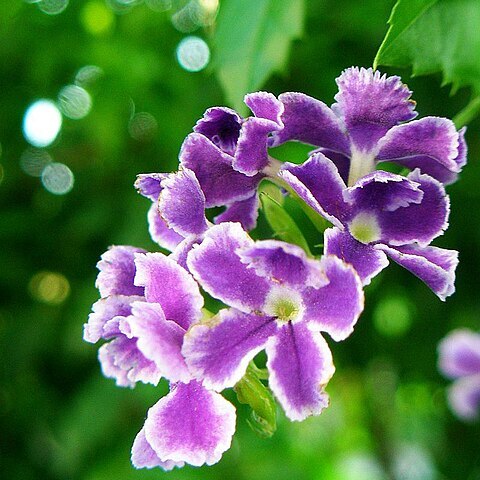Erect, trailing or subscandent unarmed or spiny shrubs or small trees. Leaves small, opposite or verticillate, simple, entire to serrate. Flowers few to many in terminal and axillary racemes or panicles; bracts small. Calyx 5-toothed, persistent. Corolla irregular with straight or curved tube; limb 2-lipped, with 5 unequal lobes. Stamens 4–5, slightly didynamous, inserted above the middle of the tube, included; in the case of 4 stamens a small staminode is sometimes present also. Ovary globose, 8–10-locular, each locule with a single erect anatropous ovule; style equalling or shorter than the corolla-tube; stigma oblique, ± capitate. Fruit fleshy, with 4–5 2-seeded pyrenes, tightly enclosed by the persistent calyx. Seeds erect, without albumen; testa membranous.
Shrubs or small trees. Stem subquadrangular, sometimes armed with spines. Leaves simple, decussate or whorled. Inflorescence axillary and terminal racemes. Flowers bracteate, pedicellate, zygomorphic. Calyx tubular, 5-ribbed, 5-toothed apically, accrescent in fruit. Corolla hypocrateriform, 5-lobed, zygomorphic; corolla tube cylindric, somewhat curved above; lobes spreading, unequal. Stamens 4, didynamous, included; filaments very short; anthers sagittate, dorsifixed. Ovary ±completely 8-locular, composed of 4 bilocular carpels; each locule with 1 ovule; style terminal; stigma obliquely subcapitate. Fruiting calyx flask-shaped, enclosing the fruit. Fruit a drupe; exocarp fleshy; endocarp hard; pyrenes 4, each bilocular and 2-seeded. Seeds without endosperm.
Shrubs. Leaves opposite or whorled, simple, margin entire or serrate-dentate. Inflorescences axillary or terminal racemes; bracts small. Calyx 5-veined, 5-dentate, persistent. Corolla 2-lipped, lower lip 3-lobed and largest, upper lip 2-lobed. Stamens 4, short, inserted above middle of cylindric corolla tube, obscurely didynamous. Ovary 8-locular; ovules 1 per locule, pendulous. Style club-shaped; stigma nearly oblique. Drupes equaling or shorter than calyx, with 2-seeded pyrenes.
Ovary globose, 4-carpellate with carpels 2-locular, each locule with a single erect anatropous ovule; style equalling or shorter than the corolla tube; stigma subcapitate, unequally 4-lobed.
Stamens 4, usually also a staminode, slightly didynamous, inserted at or above the middle of corolla tube, included; filaments subulate; anthers sagittate, dorsifixed, erect.
Fruit fleshy, drupaceous with four 2-seeded [a7] pyrenes, enclosed within the accrescent calyx.
Calyx cylindric-tubular or subcampanulate, 5-ribbed, 5-dentate, persistent, accrescent in fruit.
Corolla tubular, hypocrateriform; tube straight or curved; limb 2-lipped with 5 unequal lobes.
Flowers few to many, pedicellate, in terminal and axillary racemes or panicles; bracts small.
Shrubs or trees, erect or subscandent, unarmed or spinose; stem branched, woody.
Leaves simple, opposite or verticillate, deciduous, petiolate.
Seeds erect, without albumen.

